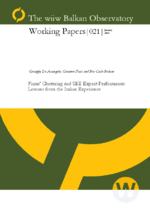Firms’ Clustering and SEE Export Performance: Lessons from the Italian Experience
Pier Carlo Padoan, Giuseppe De Arcangelis and Giovanni Ferri
wiiw Balkan Observatory Working Paper No. 21, January 2002
Like all transition economies, South Eastern Europe (SEE) countries stand to gain most from an export-led growth. Unfortunately, though, productive structure in these countries is largely made up of small and medium enterprises (SMEs) that, due to their limited size, may face obstacles to gain access to international markets. A possible way out of the conundrum is for SMEs to cluster together and, by sharing the costs of internationalization, jointly tap foreign markets. This approach has been at the heart of the successful export performance of SMEs clustered within Italy’s industrial districts. In this paper we use historical data on Italian exports (in 1971 and 1961) to quantify the boosting effect due to firms’ clustering. In particular, we use detailed data on export classified by sector and by destination country to estimate a panel gravity model on which we compute the firms’ clustering effect. Next, building on the Italian experience we design four scenarios for firms’ clustering in three SEE economies (Bulgaria, Romania and Slovenia). By means of these scenarios and applying the estimated coefficient for firms’ clustering in Italy, we simulate the firms’ clustering effect for the three SEE economies and obtain the gain in export growth over the benchmark case. Results show that an additional export growth between 3% and 11% over a five- year period could be expected.
